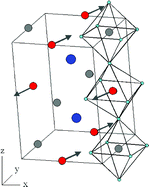Double perovskites Sr2CrSbO6 and Ca2CrSbO6 have been prepared by a solid-state procedure. The crystal and magnetic structures have been studied from X-ray (XRD) and neutron powder diffraction (NPD) data. Rietveld refinements show that the room-temperature crystal structure is monoclinic (space group P21/n), and contains an almost completely ordered array of alternating CrO6 and SbO6 octahedra sharing corners, tilted along the three pseudocubic axes according to the Glazer notation a−a−b+. The monoclinic distortion is larger in Ca2CrSbO6 than in Sr2CrSbO6, which is associated with the tilting of the CrO6 and SbO6 octahedra, displaying tilting angles φ = 13.5° and φ = 5.5°, respectively. Magnetization measurements and low-temperature NPD data show that Sr2CrSbO6 is an antiferromagnet with a Néel temperature of 12 K with an ordered magnetic moment of 1.64(4) μB per Cr3+. The propagation vector is k = 0. Ca2CrSbO6 exhibits ferromagnetic long-range order below TC = 16 K, with a saturation magnetization of 2.36 μB at 5 K. In the ferromagnetic arrangement, the Cr3+ spins are aligned approximately along the [110] direction with an ordered magnetic moment of 2.6(2) μB. To our knowledge, this is the first example of a ferromagnetic double perovskite containing a non-magnetic element in the B positions of the perovskite structure.

You have access to this article
 Please wait while we load your content...
Something went wrong. Try again?
Please wait while we load your content...
Something went wrong. Try again?


 Please wait while we load your content...
Please wait while we load your content...